Spatiotemporal Characteristics of Vegetation Net Primary Productivity on an Intensively-Used Estuarine Alluvial Island
Abstract
1. Introduction
2. Materials and Methods
2.1. Study Area
2.2. Data Sources
2.2.1. RS Images
2.2.2. Meteorological Data
2.3. Establishment of the Evaluation Model
2.3.1. NPP Calculation
2.3.2. Analysis of NPP Spatiotemporal Characteristics
2.3.3. Correlation Analysis of Main Influencing Factors
3. Results
3.1. NPP Temporal Variation Characteristics
3.2. Characteristics and Changing Trends of NPP Spatial Distribution
3.3. Correlation Analysis of Main Influencing Factors
4. Discussion
4.1. NPP Estimation Results
4.1.1. The Driving Factors for the Temporal Variations of NPP
4.1.2. Seasonal Differences in NPP between Chongming Island and Other Areas
4.1.3. Comparison of Mean NPP between Chongming Island and Other Areas
4.1.4. Analysis of the Spatiotemporal Characteristics of NPP of Different Vegetation Cover Types
4.1.5. Comparison of the Spatiotemporal Pattern of NPP between Protected and Unprotected Areas
4.2. Intrinsic Correlations of NPP with Spatial Heterogeneity Parameters
5. Conclusions
- (1)
- In the last 30 years, Chongming Island mean NPP initially increased and then slowly decreased, while total NPP gradually increased. In 2016–2017, Chongming Island total NPP was 422.32 Gg C·a−1, with an average density of 287.84 g C·m−2·a−1, respectively, which was lower than the national average. Among areas in the Yangtze River Basin, mean NPP of the study area was higher than in Qinghai and Tibet in the upper reaches but lower than those of Sichuan and Chongqing in the upper reaches, and Hubei, Anhui, and Jiangsu in the middle and lower reaches. Total NPP in spring, summer, autumn, and winter accounted for 10.78%, 59.71%, 26.11%, and 3.39%, respectively, of the annual NPP. These results corresponded to the first scientific question of this study.
- (2)
- Under multiple influences of strong sea–land interactions and various human activities, Chongming Island NPP showed the following spatiotemporal characteristics: (1) Land-cover types ranked by mean NPP from high to low were in the order: wetland vegetation, farmland, woodland, traffic land, building land, waters, ponds, industrial land, and mudflats. (2) Total NPP was highest in farmland, followed by woodland, wetland vegetation, and building land, while other land-cover types accounted for only a small proportion. (3) Among the different types of protected areas, mean NPP of core protected areas was generally lower than unprotected areas and ordinary protected areas. The ordinary protected areas had more wetland vegetation, thus they had a higher NPP than the core protected areas and unprotected areas. In the last 30 years, mean NPP of both core and ordinary protected areas fluctuated, first decreasing, then increasing, and finally decreasing again. The mean and total NPP of unprotected areas continuously increased, indicating the beneficial effects of ecological construction over the island. These results corresponded to the second scientific question of this study.
- (3)
- Chongming Island vegetation growth status and vegetation cover were the main factors that positively affected NPP. The effect of soil surface humidity on NPP increased, and soil salinity, surface temperature, and surface aridity were important NPP limiting factors. These results corresponded to the third scientific question of this study.
Author Contributions
Funding
Institutional Review Board Statement
Informed Consent Statement
Data Availability Statement
Conflicts of Interest
References
- Syvitski, J.P.M.; Kettner, A.J.; Overeem, I.; Hutton, E.W.H.; Hannon, M.T.; Brakenridge, R.G.; Day, J.; Vörösmarty, C.; Saito, Y.; Giosan, L.; et al. Sinking deltasdue to human activities. Nat. Geosci. 2009, 2, 681–686. [Google Scholar] [CrossRef]
- Huang, B.; Ouyang, Z.; Zheng, H.; Zhang, H.; Wang, X. Construction of an ecoisland: A case study of Chongming Island, China. Ocean. Coast. Manag. 2008, 51, 575–588. [Google Scholar] [CrossRef]
- Chi, Y.; Zheng, W.; Shi, H.; Sun, J.; Fu, Z. Spatial heterogeneity of estuarine wetland ecosystem health influenced by complex natural and anthro-pogenic factors. Sci. Total Environ. 2018, 634, 1445–1462. [Google Scholar] [CrossRef]
- Brückner, H.; Herda, A.; Kerschner, M.; Müllenhoff, M.; Stock, F. Life cycle of estuarine islands—From the formation to the landlocking of former islands in the environs of Miletos and Ephesos in western Asia Minor (Turkey). J. Archaeol. Sci. 2017, 12, 876–894. [Google Scholar] [CrossRef]
- Carvalho, R.C.; Woodroffe, C.D. Evolution from estuary to delta: Alluvial plain morphology and sedimentary characteristics of the Shoalhaven River mouth, southeastern Australia. Estuar. Coast. Shelf Sci. 2020, 242, 106857. [Google Scholar] [CrossRef]
- Zhang, Q.; Xu, C.; Becker, S.; Jiang, T. Sediment and runoff changes in the Yangtze River basin during past 50 years. J. Hydrol. 2006, 331, 511–523. [Google Scholar] [CrossRef]
- Ghosh, M.K.; Kumar, L.; Roy, C. Monitoring the coastline change of Hatiya Island in Bangladesh using remote sensing techniques. ISPRS J. Photogramm. 2014, 101, 137–144. [Google Scholar] [CrossRef]
- Shen, G.; Abdoul, N.I.; Zhu, Y.; Wang, Z.; Gong, J. Remote sensing of urban growth and landscape pattern changes in response to the expansion of Chongming Island in Shanghai, China. Geocarto Int. 2017, 32, 488–502. [Google Scholar] [CrossRef]
- Qiao, G.; Mi, H.; Wang, W.; Tong, X.; Li, Z.; Li, T.; Liu, S.; Hong, Y. 55-year (1960–2015) spatiotemporal shoreline change analysis using historical DISP and Landsat time series data in Shanghai. Int. J. Appl. Earth Obs. 2018, 68, 238–251. [Google Scholar]
- Kabir, M.A.; Salauddin, M.; Hossain, K.T.; Tanim, I.A.; Saddam, M.M.H.; Ahmad, A.U. Assessing the shoreline dynamics of Hatiya Island of Meghna estuary in Bangladesh using multiband satellite imageries and hydro-meteorological data. Reg. Stud. Mar. Sci. 2020, 35, 101167. [Google Scholar]
- Qiu, C.; Zhu, J.R. Influence of seasonal runoff regulation by the Three Gorges Reservoir on saltwater intrusion in the Changjiang River Estuary. Cont. Shelf Res. 2013, 71, 16–26. [Google Scholar] [CrossRef]
- Arkema, K.; Guannel, G.; Verutes, G.; Wood, S.A.; Guerry, A.; Ruckelshaus, M.; Kareiva, P.; Lacayo, M.; Silver, J.M. Coastal habitats shield people and property from sea-level rise and storms. Nat. Clim. Change 2013, 3, 913–918. [Google Scholar] [CrossRef]
- Johnston, A.; Slovinsky, P.; Yates, K.L. Assessing the vulnerability of coastal infrastructure to sea level rise using multi-criteria analysis in Scarborough, Maine (USA). Ocean. Coast. Manag. 2014, 95, 176–188. [Google Scholar] [CrossRef]
- Du, Q.; Zhong, Q.C.; Wang, K.Y. Root Effect of Three Vegetation Types on Shoreline Stabilization of Chongming Island, Shanghai. Pedosphere 2010, 20, 692–701. [Google Scholar] [CrossRef]
- Wu, S.; Cheng, H.; Xu, Y.J.; Li, J.; Zheng, S. Decadal changes in bathymetry of the Yangtze River Estuary: Human impacts and potential saltwater intrusion. Estuar. Coast. Shelf Sci. 2016, 182, 158–169. [Google Scholar] [CrossRef]
- Chen, Y.; Dong, J.; Xiao, X.; Zhang, M.; Tian, B.; Zhou, Y.; Li, B.; Ma, Z. Land claim and loss of tidal flats in the Yangtze Estuary. Sci. Rep. 2016, 6, 24018. [Google Scholar] [CrossRef]
- Sun, N.; Zhu, W.; Cheng, Q. GF-1 and Landsat observed a 40-year wetland spatiotemporal variation and its coupled environmental factors in Yangtze River estuary. Estuar. Coast. Shelf Sci. 2018, 207, 30–39. [Google Scholar] [CrossRef]
- Allison, M.A.; Weathers, H.D.; Meselhe, E.A. Bottom morphology in the Song Hau distributary channel, Mekong River Delta, Vietnam. Cont. Shelf Res. 2017, 147, 51–61. [Google Scholar] [CrossRef]
- Chi, Y.; Zhao, M.; Sun, J.; Xie, Z.; Wang, E. Mapping soil total nitrogen in an estuarine area with high landscape fragmentation using a multiple-scale approach. Geoderma 2019, 339, 70–84. [Google Scholar] [CrossRef]
- Fang, J.; Liu, M.; Liu, W.; Pathak, S.; Li, S.; Tang, X.; Zhou, L.; Sun, F. Piloting a capital-based approach for characterizing and evaluating drivers of island sustainability- An application in Chongming Island. J. Clean. Prod. 2020, 261, 121123. [Google Scholar] [CrossRef]
- Yan, B.; Wang, J.; Li, S.; Cui, L.; Ge, Z.; Zhang, L. Assessment of socio-economic vulnerability under sea level rise coupled with storm surge in the Chongming County, Shanghai. Acta Ecol. Sin. 2016, 36, 91–98. [Google Scholar]
- Chi, Y.; Shi, H.; Guo, Z.; Ding, D. Connotation, features and causes of islandecological vulnerability. Acta Oceanol. Sin. 2015, 12, 93–105. [Google Scholar]
- Ding, D.; Jiang, Y.; Wu, Y.; Shi, T. Landscape character assessment of water-land ecotone in an island area for landscape environment promotion. J. Clean. Prod. 2020, 259, 120934. [Google Scholar]
- Gang, C.; Zhou, W.; Wang, Z.; Chen, Y.; Li, J.; Chen, J.; Qi, J.; Odeh, I.; Groisman, P.Y. Comparative assessmentof grassland NPP dynamics in response to climate change in China, North America, Europe and Australia from 1981 to 2010. J. Agron. Crop. Sci. 2015, 201, 57–68. [Google Scholar] [CrossRef]
- Taylor, P.G.; Cleveland, C.C.; Wieder, W.R.; Sullivan, B.W.; Doughty, C.E.; Dobrowski, S.Z.; Townsend, A.R. Temperature and rainfall interact to control carbon cycling in tropical forests. Ecol. Lett. 2017, 20, 779–788. [Google Scholar]
- Chen, Y.; Tao, Y.; Cheng, Y.; Ju, W.; Ye, J.; Hickler, T.; Liao, C.; Feng, L.; Ruan, H. Great uncertainties in modeling grazing impact on carbon sequestration: A multi-model inter-comparison in temperate Eurasian Steppe. Environ. Res. Lett. 2018, 13, 075005. [Google Scholar] [CrossRef]
- Jia, Y.; Niu, B.; Qian, J. Estimation of ecosystem NPP in Haizhou Bay based on CASA. Geospat. Inform. 2020, 18, 41–44. [Google Scholar]
- Gang, C.; Zhao, W.; Zhao, T.; Zhang, Y.; Gao, X.; Wen, Z. The impacts of land conversion and management measures on the grassland net primary productivity over the Loess Plateau, Northern China. Sci. Total Environ. 2018, 645, 827–836. [Google Scholar] [CrossRef]
- Chen, H.; Zhao, X.; Lin, Q.; Li, G.; Kong, W. Spring watering interactively improves aboveground net primary productivity and soil microbial biomass in a semi-arid grassland of China. Catena 2020, 189, 104478. [Google Scholar] [CrossRef]
- Zheng, Z.; Zhu, W.; Zhang, Y. Seasonally and spatially varied controls of climatic factors on net primary productivity in alpine grasslands on the Tibetan Plateau. Glob. Ecol. Conserv. 2020, 21, e00814. [Google Scholar] [CrossRef]
- Clark, D.A.; Brown, S.; Kicklighter, D.W.; Chambers, J.Q.; Thomlinson, J.R.; Ni, J. Measuring net primary production in forests: Concepts and field methods. Ecol. Appl. 2001, 11, 356–370. [Google Scholar] [CrossRef]
- Wang, C.; Jiang, Q.; Engel, B.; Mercado, J.A.V.; Zhang, Z. Analysis on net primary productivity change of forests and its multi–level driving mechanism—A case study in Changbai Mountains in Northeast China. Technol. Forecast. Soc. Chang. 2020, 153, 119939. [Google Scholar] [CrossRef]
- Komiyama, A.; Ong, J.E.; Poungparn, S. Allometry, biomass, and productivity of mangrove forests: A review. Aquat. Bot. 2008, 89, 128–137. [Google Scholar] [CrossRef]
- Kamruzzaman, M.; Osawa, A.; Deshar, R.; Sharma, S.; Mouctar, K. Species composition, biomass, and net primary productivity of mangrove forest in Okukubi River, Okinawa Island, Japan. Reg. Stud. Mar. Sci. 2017, 12, 19–27. [Google Scholar] [CrossRef]
- Ohtsuka, T.; Tomotsune, M.; Suchewaboripont, V.; Iimura, Y.; Kida, M.; Yoshitake, S.; Kondo, M.; Kinjo, K. Stand dynamics and aboveground net primary productivity of a mature subtropical mangrove forest on Ishigaki Island, southwestern Japan. Reg. Stud. Mar. Sci. 2019, 27, 100516. [Google Scholar] [CrossRef]
- Mao, F.; Du, H.; Li, X.; Ge, H.; Cui, L.; Zhou, G. Spatiotemporal dynamics of bamboo forest net primary productivity with climate variations in Southeast China. Ecol. Indic. 2020, 116, 106505. [Google Scholar]
- Koga, N.; Smith, P.; Yeluripati, J.B.; Shirato, Y.; Kimura, S.D.; Nemoto, M. Estimating net primary production and annual plant carbon inputs and modeling future changes in soil carbon stocks in arable farmlands of northern Japan. Agr. Ecosyst. Environ. 2011, 144, 51–60. [Google Scholar]
- Artacho, P.; Bonomelli, C. Net primary productivity and allocation to fine-root production in field-grown sweet cherry trees under different soil nitrogen regimes. Sci. Hortic. 2017, 219, 207–215. [Google Scholar] [CrossRef]
- Peng, H.; Jia, Y.; Zhan, C.; Xu, W. Topographic controls on ecosystem evapotranspiration and net primary productivity under climate warming in the Taihang Mountains, China. J. Hydrol. 2020, 581, 124394. [Google Scholar]
- Wu, Y.; Wang, P.; Liu, X.; Chen, J.; Song, M. Analysis of regional carbon allocation and carbon trading based on net primary productivity in China. China Econ. Rev. 2020, 60, 101401. [Google Scholar] [CrossRef]
- Li, J.; Wang, Z.; Lai, C. Severe drought events inducing large decrease of net primary productivity in mainland China during 1982–2015. Sci. Total Environ. 2020, 703, 135541. [Google Scholar] [CrossRef] [PubMed]
- Mohamed, M.A.A.; Babiker, I.S.; Chen, Z.M.; Ikeda, K.; Ohta, K.; Kato, K. The role of climate variability in the inter-annual variation of terrestrial net primary production (NPP). Sci. Total Environ. 2004, 332, 123–137. [Google Scholar] [CrossRef] [PubMed]
- Du, E.; Vries, W. Nitrogen-induced new net primary production and carbon sequestration in global forests. Environ. Pollut. 2018, 242, 1476–1487. [Google Scholar] [CrossRef] [PubMed]
- Potter, C.S.; Randerson, J.T.; Field, C.B.; Matson, P.A.; Vitousek, P.M.; Mooney, H.A.; Klooster, S.A. Terrestrial ecosystem production: A process model based on global satellite and surface data. Glob. Biogeochem. Cycles 1993, 7, 811–841. [Google Scholar] [CrossRef]
- Field, C.B.; Randerson, J.T.; Malmström, C.M. Global net primary production: Combining ecology and remote sensing. Remote Sens. Environ. 1995, 51, 74–88. [Google Scholar] [CrossRef]
- Prince, S.D. A model of regional primary production for use with coarse resolution satellite data. Int. J. Remote Sens. 1991, 12, 1313–1330. [Google Scholar] [CrossRef]
- Veroustraete, F.; Sabbe, H.; Eerens, H. Estimation of carbon mass fluxes over Europe using the C-Fix model and Euroflux data. Remote Sens. Environ. 2002, 83, 376–399. [Google Scholar]
- Tang, Z.; Wang, H.; Li, X.; Chi, D.; Li, X. Variation of vegetation net primary productivity and its influential factors in Xilingol League from 2006 to 2015. Pratacultural 2018, 35, 2812–2821. [Google Scholar]
- Chi, Y.; Shi, H.; Wang, X.; Li, J.; Feng, A. The spatial distribution and impact factors of net primary productivity in the island ecosystem of five southern islands of Miaodao Archipelago. Acta Ecol. Sin. 2015, 35, 8094–8106. [Google Scholar]
- Yin, L.; Zheng, W.; Gao, M.; Lu, J. Spatial and temporal heterogeneity of net primary productivity and landscape patterns on five northern islands of Miaodao Archipelago. Acta Oceanol. Sin. 2020, 42, 110–118. [Google Scholar]
- Bureau of Planning, Land and Resources of Shanghai. Master Plan. and General Land-Use Plan. of Chongming Disrtice, Shanghai, 2017–2035; People’s Government of Chongming District: Shanghai, China, 2018.
- Chi, Y.; Wang, E.; Wang, J. Identifying the anthropogenic influence on the spatial distuibution of plant diversity in an estuarine island through multiple gradients. Glob. Ecol. Conserv. 2020, 21, e00833. [Google Scholar] [CrossRef]
- Cai, W.; Song, X.; Zhang, P.; Xin, Z.; Zhou, Y.; Wang, Y.; Wei, W. Carbon emissions and driving forces of an island economy: A case study of Chongming Island, China. J. Clean. Prod. 2020, 254, 120028. [Google Scholar] [CrossRef]
- Shanghai Municipal People’s Government. Chongming’s 13th Five-Year Plan. for World-Class. Eco-Island Development; Shanghai Municipal People’s Government: Shanghai, China, 2016.
- Luo, P.; Yang, Y.; Wang, H.; Gu, Y.; Xu, J.; Li, Y. Water footprint and scenario analysis in the transformation of Chongming into an international eco-island. Resour. Conserv. Recy. 2018, 132, 376–385. [Google Scholar] [CrossRef]
- Wang, Y.; Yang, C.; Li, J.; Shen, S. The chemical composition and source identification of soil dissolved organic matter in riparian buffer zones from Chongming Island, China. Chemosphere 2014, 111, 505–512. [Google Scholar] [CrossRef]
- Gu, W. Climate change characteristics of Chongming Island in recent 35 years. In Proceedings of the 26th Annual Meeting of Chinese Meteorological Society, Hangzhou, China, 14 October 2009; pp. 1147–1152. [Google Scholar]
- Huang, K.; Lin, K.; Guo, J.; Zhou, X.; Wang, J.; Zhao, J.; Zhou, P.; Xu, F.; Liu, L.; Zhang, W. Polybrominated diphenyl ethers in birds from Chongming Island, Yangtze estuary, China: Insight into migratory behavior. Chemosphere 2013, 91, 1416–1425. [Google Scholar] [CrossRef]
- Chi, Y.; Zhang, Z.; Gao, J.; Xie, Z.; Zhao, M.; Wang, E. Evaluating landscape ecological sensitivity of an estuarine island based on landscape pattern across temporal and spatial scales. Ecol. Indic. 2019, 101, 221–237. [Google Scholar] [CrossRef]
- He, F.; Xue, J.; Mu, H. Estimation of total solar radiation and its temporal distributions over Shanghai Area. Resour. Sci. 2010, 32, 693–700. [Google Scholar]
- Jin, L. Variation characteristics of sunshine duration and its influencing factors in Shanghai inrecent 50 years. Meteorol. Sci. Technol. 2012, 40, 293–298. [Google Scholar]
- Bureau of Statistics of Chongming District. Statistical Yearbook of Chongming District in Shanghai (2010–2017); Bureau of Statistics of Chongming District: Shanghai, China, 2018.
- Compilation group of sprinkler irrigation engineering design manual. In Sprinkler Irrigation Engineering Design Manual; China Water Power Press: Beijing, China, 1989.
- Wang, S.; Wang, H.; Fang, Y.; Li, K. Ability of plant carbon fixation in the coastal wetland of Chongming Island. Chin. J. Ecol. 2014, 33, 915–921. [Google Scholar]
- Chi, Y.; Shi, H.; Sun, J.; Li, J.; Yang, F.; Fu, Z. Spatio-temporal characteristics and main influencing factors of vegetation net primary productivity in the Yellow River Delta in recent 30 years. Acta Ecol. Sin. 2018, 38, 2683–2697. [Google Scholar]
- Running, S.W.; Thornton, P.E.; Nemani, R.; Glassy, J.M. Global terrestrial gross and net primary productivity from the earth observing system. In Methods in Ecosystem Science; Sala, O.E., Jackson, R.B., Mooney, H.A., Howarth, R.W., Eds.; Springer: New York, NY, USA, 2000. [Google Scholar]
- Zhu, W.; Pan, Y.; Zhang, J. Estimation of net primary productivity of Chinese terrestrial vegetation based on remote sensing. Chin. J. Plant. Ecol. 2007, 31, 413–424. [Google Scholar]
- Xu, H. A remote sensing urban ecological index and its application. Acta Ecol. Sin. 2013, 33, 7853–7862. [Google Scholar]
- Douaoui, A.E.K.; Nicolas, H.; Walter, C. Detecting salinity hazards within a semiarid context by means of combining soil and remote-sensing data. Geoderma 2006, 134, 217–230. [Google Scholar] [CrossRef]
- Chi, Y.; Sun, J.; Liu, W.; Wang, J.; Zhao, M. Mapping coastal wetland soil salinity in different seasons using an improved comprehensive land surface factor system. Ecol. Indic. 2019, 107, 105517. [Google Scholar] [CrossRef]
- Wang, Y.; Deng, C.; Liu, Y.; Niu, Z.; Li, Y. Identifying change in spatial accumulation of soil salinity in an inland river watershed, China. Sci. Total Environ. 2018, 621, 177–185. [Google Scholar] [CrossRef]
- Liu, Q.; Liu, G.; Huang, C.; Xie, C. Comparison of tasselled cap transformations based on the selective bands of Landsat 8 OLI TOA reflectance images. Int. J. Remote Sens. 2015, 36, 417–441. [Google Scholar] [CrossRef]
- Hu, X.; Xu, H. A new remote sensing index for assessing the spatial heterogeneity in urban ecological quality: A case from Fuzhou City, China. Ecol. Indicat. 2018, 89, 11–21. [Google Scholar] [CrossRef]
- Ma, L.; Ma, F.; Li, J.; Gu, Q.; Yang, S.; Wu, D.; Feng, J.; Ding, J. Characterizing and modeling regional-scale variations in soil salinity in the arid oasis of Tarim Basin, China. Geoderma 2017, 305, 1–11. [Google Scholar] [CrossRef]
- Emami, H.; Mojaradi, B.; Safari, A. The effect of soil salinity on the use of the universal triangle method to estimate saline soil moisture from Landsat data: Application to the SMAPEx-2 and SMAPEx-3 campaigns. Int. J. Remote Sens. 2017, 38, 6623–6652. [Google Scholar]
- Chi, Y.; Shi, H.; Zheng, W.; Sun, J. Simulating spatial distribution of coastal soil carbon content using a comprehensive land surface factor system based on remote sensing. Sci. Total Environ. 2018, 628-629, 384–399. [Google Scholar] [CrossRef]
- Allbed, A.; Kumar, L.; Aldakheel, Y.Y. Assessing soil salinity using soil salinity and vegetation indices derived from IKONOS high-spatial resolution imageries: Applications in a date palm dominated region. Geoderma 2014, 230–231, 1–8. [Google Scholar] [CrossRef]
- Sobrino, J.A.; Coll, C.; Caselles, V. Atmospheric correction for land surface temperature using NOAA-11 AVHRR channels 4 and 5. Remote Sens. Environ. 1991, 38, 19–34. [Google Scholar] [CrossRef]
- Xu, H. A new index for delineating built-up land features in satellite imagery. Int. J. Remote Sens. 2008, 29, 4269–4276. [Google Scholar] [CrossRef]
- Xu, H.; Tang, F. Analysis of new characteristics of the first Landsat 8 image and their eco-environmental significance. Acta Ecol. Sin. 2013, 33, 3249–3257. [Google Scholar]
- Chi, Y.; Sun, J.; Sun, Y.; Liu, S.; Fu, Z. Multi-temporal characterization of land surface temperature and its relationships with normalized difference vegetation index and soil moisture content in the Yellow River Delta, China. Glob. Ecol. Conserv. 2020, 23, e01092. [Google Scholar] [CrossRef]
- Yang, T.; Zhang, X. Benchmarking the building energy consumption and solar energy trade-offs of residential neighborhoods on Chongming Eco-Island, China. Appl. Energ. 2016, 180, 792–799. [Google Scholar] [CrossRef]
- Li, J. Study on the dynamic changes of water front in Chongming Island area at the Yangtze Delta. J. Gansu Sci. 2020, 32, 17–21. [Google Scholar]
- Hu, H.; Hu, G.; Cheng, H. GIS-based visualized analysis of shoals evolution around alluvial islands in the Changjiang estuary for the recent 120 years. Geogr. Geo-Inf. Sci. 2007, 23, 85–88. [Google Scholar]
- Ren, L.; Li, X.; Yang, S.; Yan, Z.; Huang, X. The impact of salt marsh change on sediment accumulation and wave attenuation at the East Chongming Island. Acta Ecol. Sin. 2014, 34, 3350–3358. [Google Scholar]
- Cao, M. The experience and revelation of the governance by law from the construction of world-class eco-islands. J. Peking Univ. 2019, 56, 149–160. [Google Scholar]
- Tao, B.; Li, K.; Shao, X.; Cao, M. Temporal and spatial pattern of net primary production of terrestrial ecosystems in China. Acta Geogr. Sin. 2003, 58, 372–380. [Google Scholar]
- Gu, J.; Li, X.; Huang, C.; Zhang, X.; Jin, X. Simulating net primary productivity of Chinese terrestrial vegetation during 2002-2010. J. Lanzou Univ. (Nat. Sci.) 2013, 49, 203–213. [Google Scholar]
- Wei, Y.; Wang, L.; Shi, Y.; Li, L. Net primary productivity of grassland resources monitoring based on remote data in Qinghai province. Sci. Geogr. Sin. 2012, 32, 621–627. [Google Scholar]
- Han, W.; Zhang, C.; Zeng, Y.; Liu, G. Spatio-temporal changes and driving factors in the net primary productivity of Lhasa River Basin from 2000 to 2015. Acta Ecol. Sin. 2018, 38, 8787–8798. [Google Scholar]
- Zhang, Y.; Qi, W.; Zhou, C.; Ding, M.; Liu, L.; Gao, J.; Bai, W.; Wang, Z.; Zheng, D. Spatial and temporal variability in the net primary production of alpine grassland on the Tibetan Plateau since 1982. J. Geogr. Sci. 2014, 24, 269–287. [Google Scholar]
- Liu, S.; Lu, T.; Tang, B.; Wu, Y.; Wu, N. Spatial-temporal variations of net primary productivity of Sichuan Vegetation based on CASA model. J. Sichuan Agr. Univ. 2013, 31, 269–282. [Google Scholar]
- Zhang, R.; Luo, H.; Zhang, R.; Liu, G.; Zheng, H.; Yang, T. Estimation of vegetation net primary productivity in Chongqing and evaluation of its ecological services value. J. Southwest Univ. 2015, 37, 40–46. [Google Scholar]
- Kong, C.; Yue, Y.; Xu, K. Spatial-temporal variation of vegetation net primary productivity and its response to climate change in Jianghan plain from 2000 to 2015. Resour. Environ. Yangtze Basin 2019, 28, 1460–1469. [Google Scholar]
- Yuan, J.; Shen, F.; Wang, T.; Luo, X. Impact of land use/cover change on regional net primary productivity in Wanjiang city belt during the period from 2000 to 2010. Res. Soil Water Conserv. 2016, 23, 245–250. [Google Scholar]
- Wang, S.; Liu, Z. Analysis of spatiotemporal distribution characteristics of vegetation NPP in Jiangsu province. J. Nanjing Univ. Inf. Sci. Tech. 2012, 4, 321–325. [Google Scholar]
- Liu, L.; Han, M.; Liu, Y.; Pan, B. Spatial distribution of wetland vegetation biomass and its influencing factors in the Yellow River Delta Nature Reserve. Acta Ecol. Sin. 2017, 37, 4346–4355. [Google Scholar]
- Mou, X.; Sun, Z.; Liu, X. Biomass spatial fractal characteristics and phosphorus nutrient dynamics of Suaeda salsa under different growth conditions of the intertidal zone in the Yellow River estuary. Acta Prataculturae Sin. 2012, 21, 45–53. [Google Scholar]
- Song, H.; Mou, X.; Liu, X. Anthropogenic effect on wetland vegetation growth in the yellow river delta. Ecol. Environ. Sci. 2019, 28, 2307–2314. [Google Scholar]
- West, T.O.; Marland, G. A synthesis of carbon sequestration, carbon emissions, and net carbon flux in agriculture: Comparing tillage practices in the United States. Agric. Ecosyst. Environ. 2002, 91, 217–232. [Google Scholar]
- Shi, Z. The Survey and Analysis of Urban. Forestry and Its Development Trend in Chongming Country; Nanjing Agricultural University: Nanjing, China, 2010. [Google Scholar]
- Yan, R.; Ke, S. The impact of cultivation of tree crops on timber supply capacity of planted forests: Inhibition and promotion? An analysis based on forest inventory panel data in 12 provinces of south China. Chin. Rural Econ. 2019, 5, 38–53. [Google Scholar]
- Wang, L. Analysis on the change of land use and landscape spatial pattern of eastern Chongming Island. Territory Nat. Resour. Study 2011, 2, 19–21. [Google Scholar]
- Zhu, Y.; Li, J.; Meng, C.; Wu, T.; Zhang, T. Land use change in the eastern part of Chongming Island in Shanghai in recent two decades. Chin. J. Appl. Ecol. 2007, 18, 2040–2044. [Google Scholar]
- Liski, J.; Nissinen, A.; Erhard, M.; Taskinen, O. Climatic effects on litter decomposition from arctic tundra to tropical rainforest. Glob. Chang. Biol. 2003, 9, 575–584. [Google Scholar] [CrossRef]
- Gao, Y.; Qi, Z.; Zhong, Q.; Fan, T.; Li, S.; Wang, K.; Zhu, H.; Zhou, T. Responses of soil microbial biomass to long-term simulated warming in Eastern Chongming Island wetlands, China. Acta Ecol. Sin. 2018, 38, 711–720. [Google Scholar]
- Tan, K.; Chen, J.; Zhang, W.; Liu, K.; Tao, P.; Cheng, X. Estimation of soil surface water contents for intertidal mudflats using a near-infrared long-range terrestrial laser scanner. ISPRS J. Photogramm. 2019, 159, 129–139. [Google Scholar] [CrossRef]
- Aragüés, R.; Medina, E.T.; Zribi, W.; Clavería, I.; Álvaro-Fuentes, J.; Faci, J. Soil salinization as a threat to the sustainability of deficit irrigation under present and expected climate change scenarios. Irrig. Sci. 2014, 33, 67–79. [Google Scholar]
- Cassel, F.; Goorahoo, D.; Sharmasarkar, S. Salinization and yield potential of a salt-laden Californian soil: An in situ geophysical analysis. Water Air Soil Poll. 2015, 226, 422. [Google Scholar] [CrossRef]
- Cui, L.; Li, G.; Ou, Y.; Chen, J.; Liao, H.; Zhao, G. Response of variation of net primary productivity to edaphic factors in the coastal salt marshes. Acta Ecol. Sin. 2020, 19, 1–12. [Google Scholar]
- Tian, H.; Xu, X.; Song, X. Drought impacts on terrestrial ecosystem productivity. J. Plant. Ecol. 2007, 31, 231–241. [Google Scholar]
- Rikimaru, A.; Roy, P.S.; Miyatake, S. Tropical forest cover density mapping. Trop. Ecol. 2002, 43, 39–47. [Google Scholar]
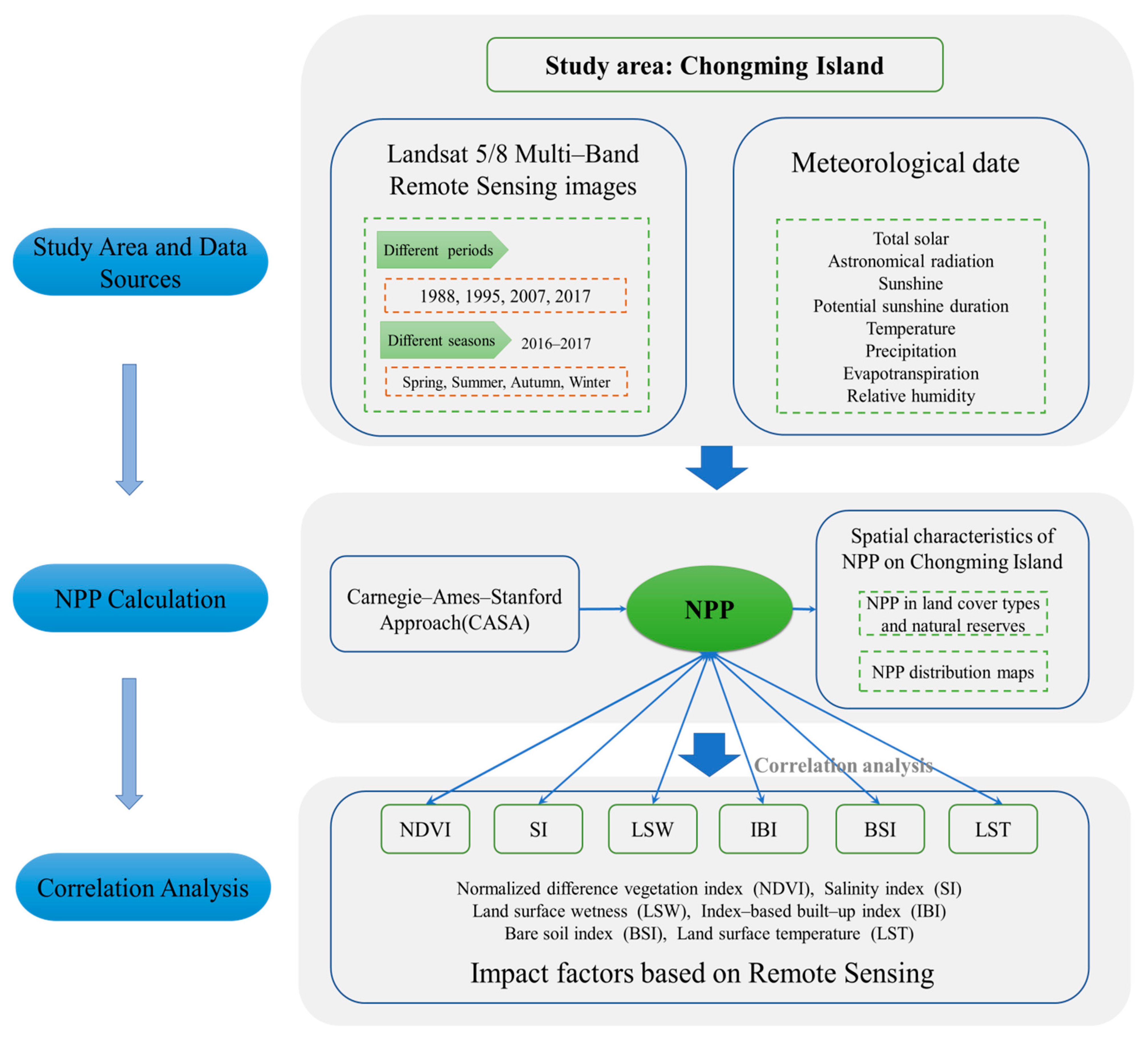
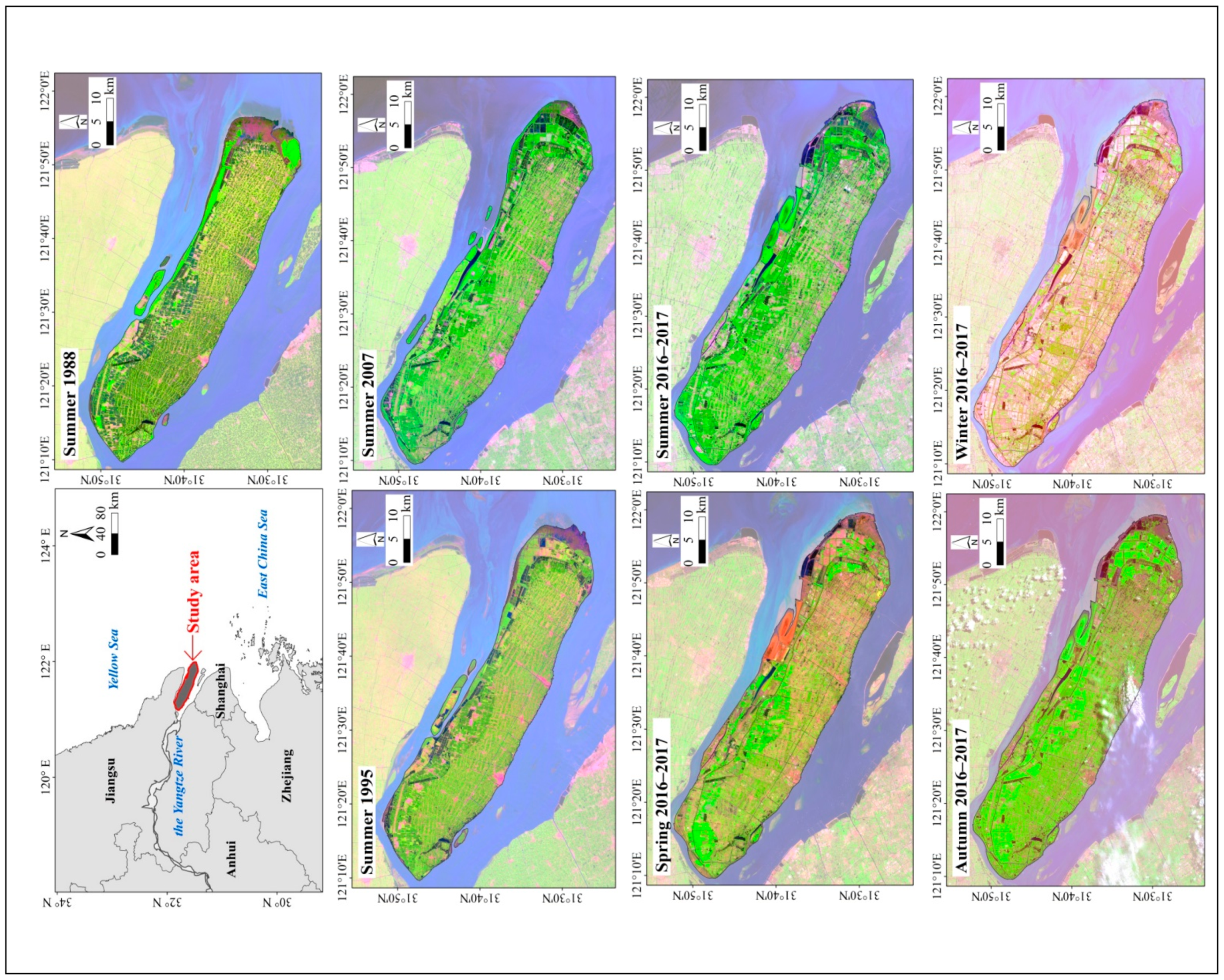
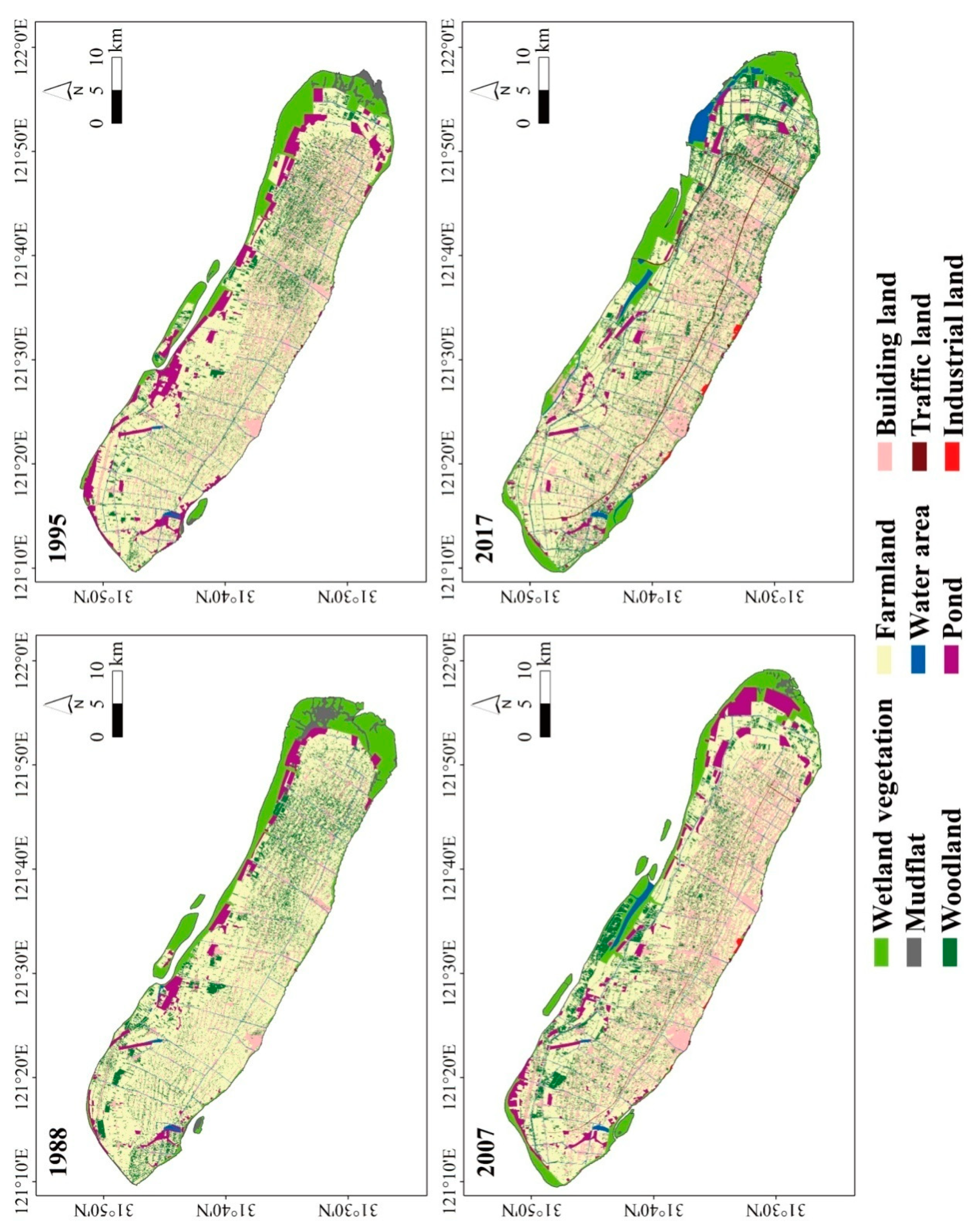
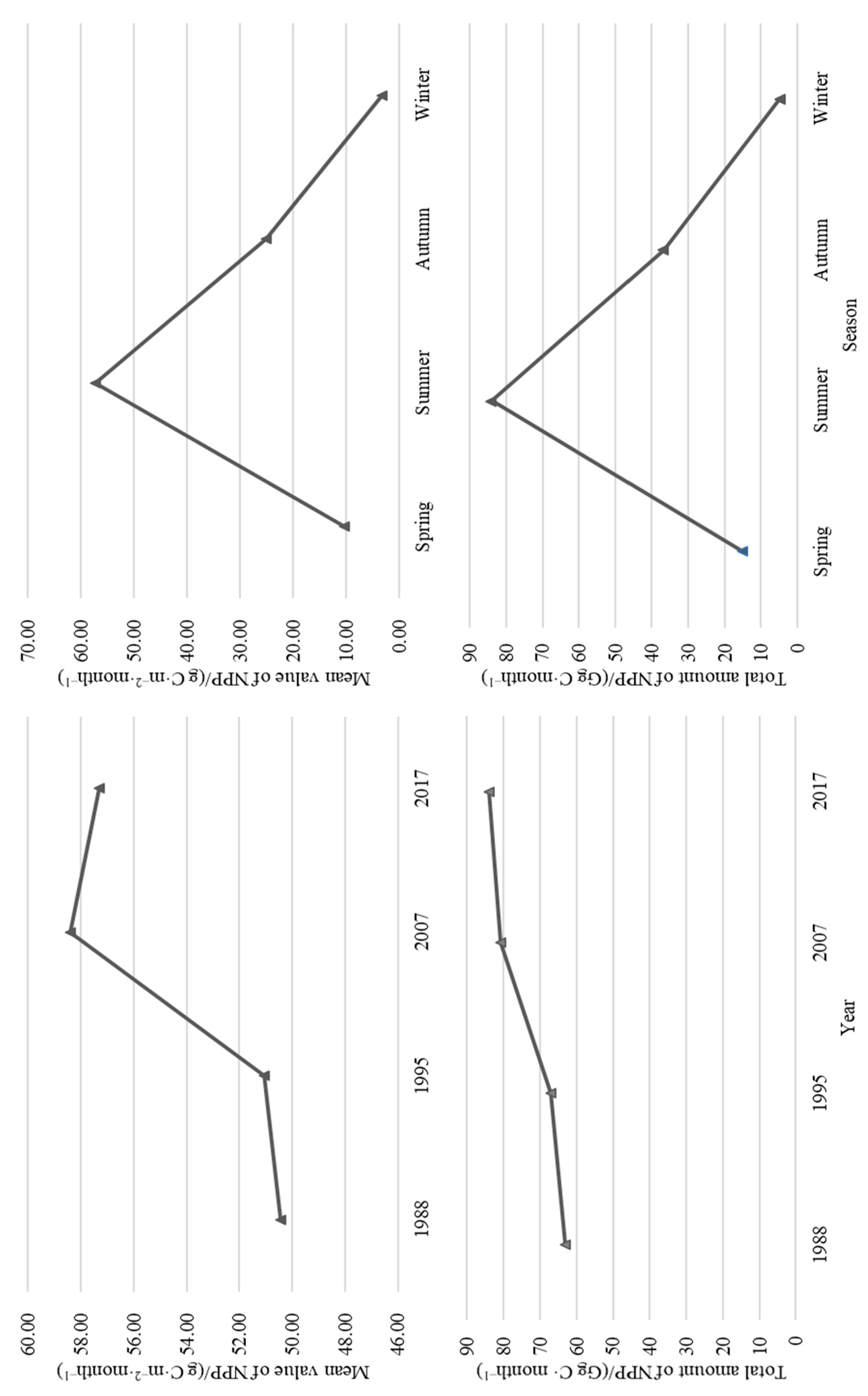
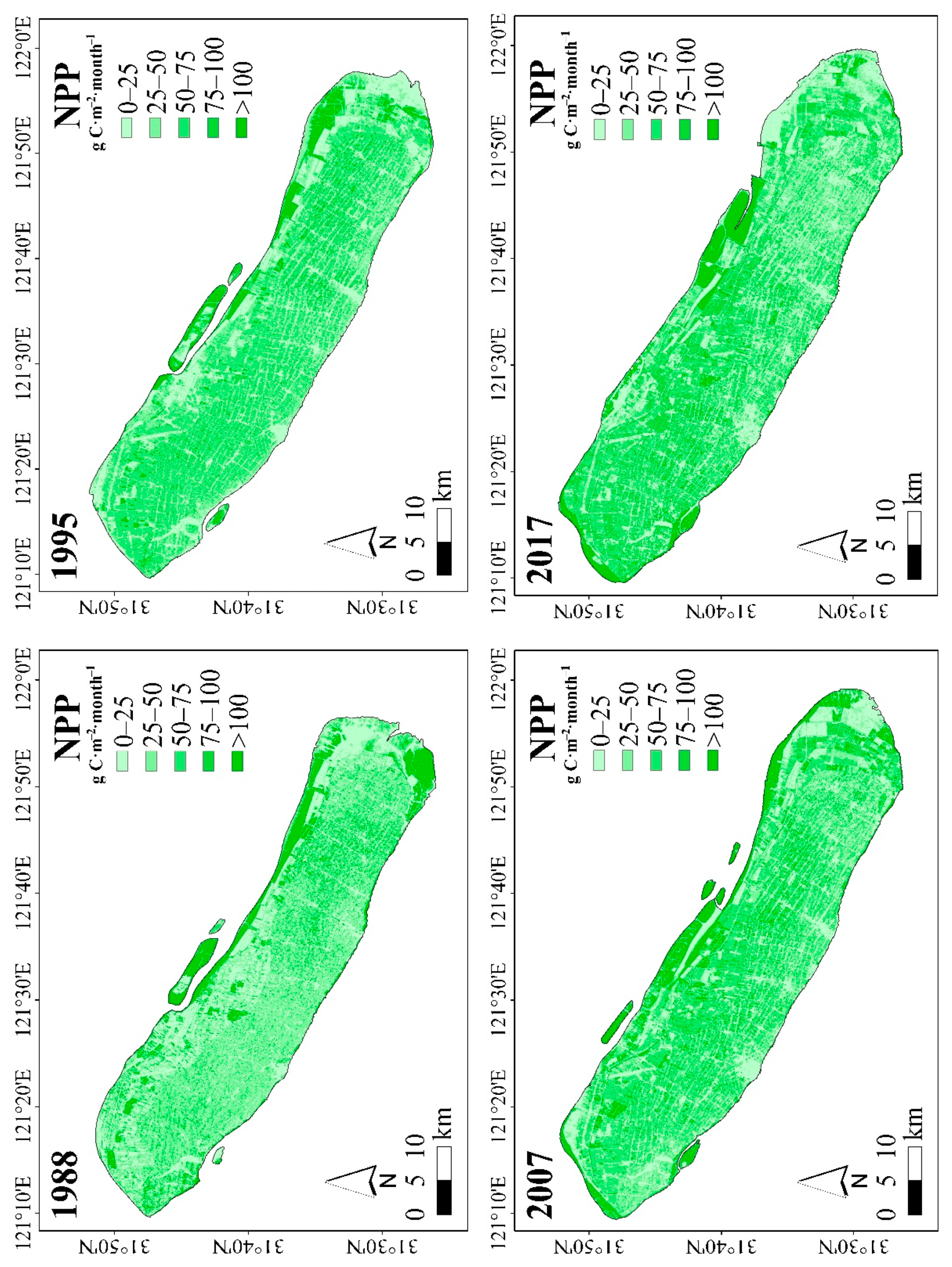
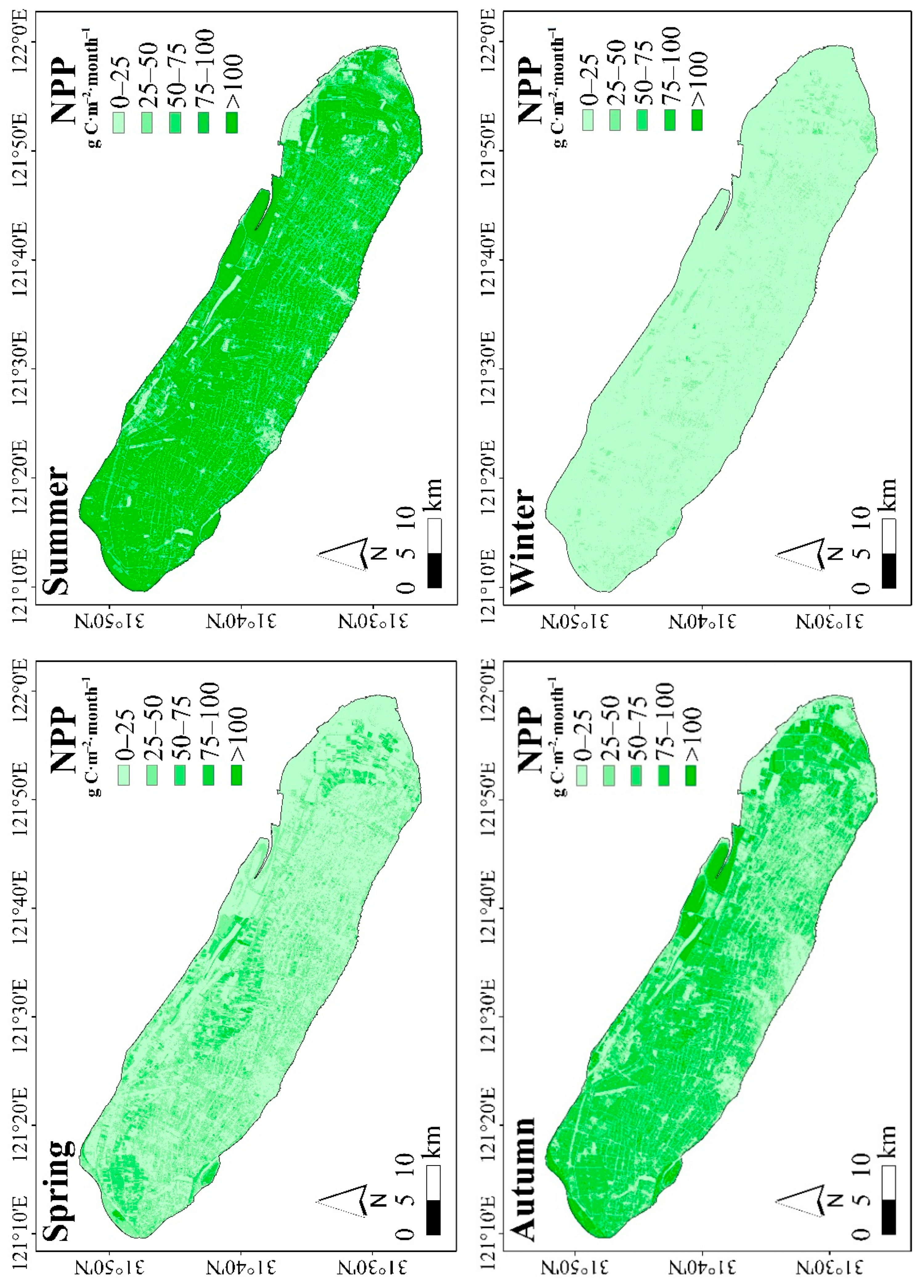
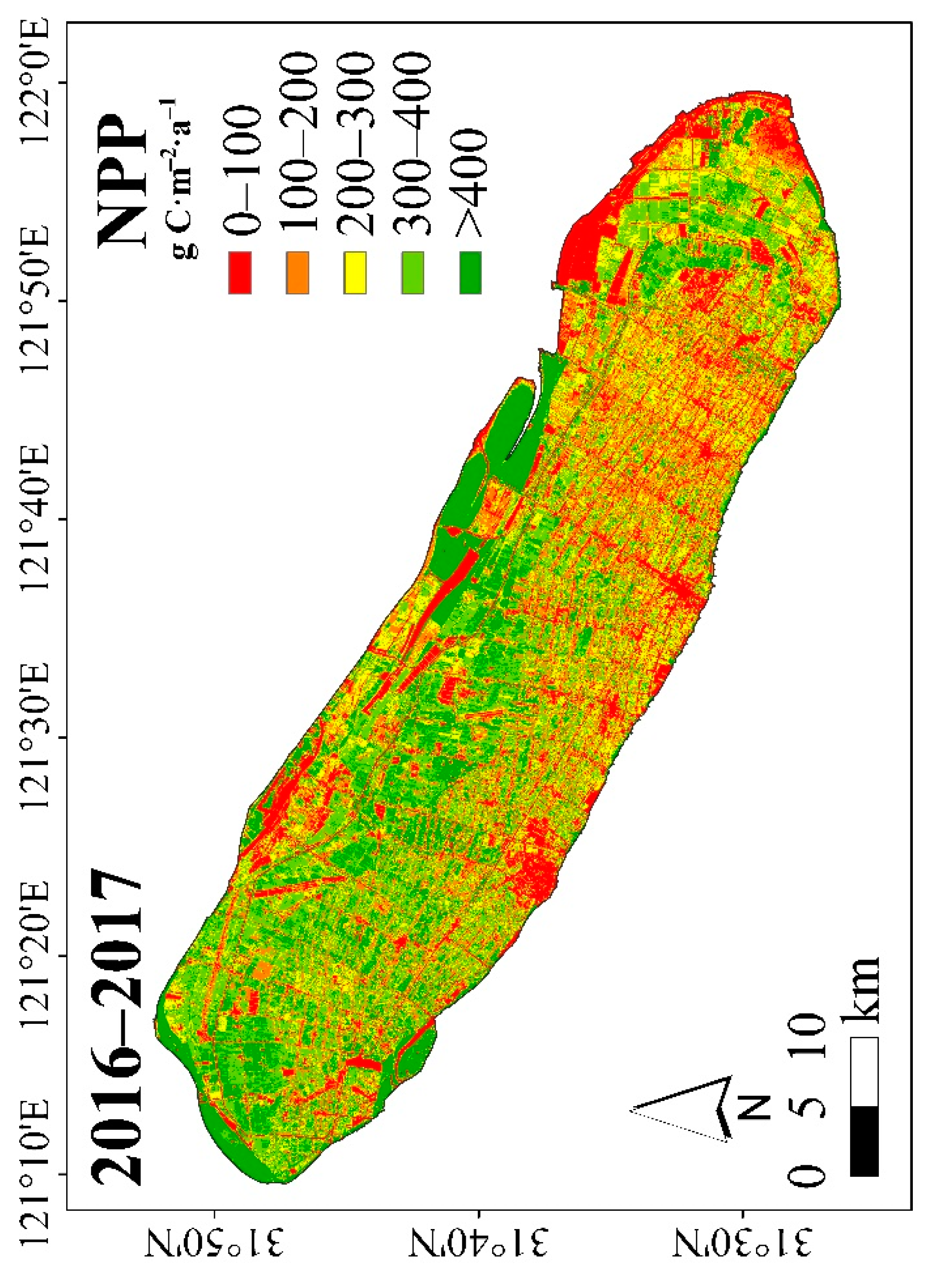
| Item | Wetland Vegetation | Woodland | Farmland | Others |
|---|---|---|---|---|
| ξmax | 1.257 | 0.942 | 0.573 | 0.389 |
| Items | Mean Value/(g C·m−2·month−1) | Total Amount/(Gg C·month−1) | ||||||
|---|---|---|---|---|---|---|---|---|
| 1988 | 1995 | 2007 | 2017 | 1988 | 1995 | 2007 | 2017 | |
| Wetland vegetation | 108.25 | 75.52 | 107.39 | 110.00 | 16.38 | 9.36 | 13.58 | 16.01 |
| Mudflat | 7.51 | 3.71 | 7.49 | 2.18 | 0.19 | 0.06 | 0.04 | 0.01 |
| Woodland | 75.71 | 73.41 | 90.04 | 58.87 | 12.74 | 11.69 | 15.15 | 13.70 |
| Farmland | 39.89 | 52.70 | 57.51 | 60.86 | 30.09 | 37.88 | 41.32 | 44.24 |
| Water area | 20.46 | 30.27 | 25.53 | 19.10 | 0.33 | 0.60 | 0.86 | 1.01 |
| Pond | 17.99 | 15.18 | 18.33 | 16.56 | 1.04 | 1.60 | 1.66 | 0.70 |
| Building land | 28.86 | 34.47 | 34.02 | 31.75 | 2.35 | 6.02 | 8.18 | 8.11 |
| Traffic land | 9.18 | 7.08 | 32.70 | 42.53 | 0.00 | 0.00 | 0.13 | 0.25 |
| Industrial land | 0.00 | 0.00 | 8.06 | 8.24 | 0.00 | 0.00 | 0.02 | 0.02 |
| Core protected areas | 133.77 | 6.37 | 57.84 | 36.64 | 1.71 | 0.05 | 1.18 | 1.12 |
| Ordinary protected areas | 80.67 | 43.22 | 96.28 | 63.54 | 1.20 | 1.23 | 4.72 | 4.04 |
| Unprotected areas | 49.86 | 51.47 | 56.84 | 57.40 | 61.74 | 65.91 | 75.03 | 78.89 |
| Items | Mean Value | Total Amount | ||||||||
|---|---|---|---|---|---|---|---|---|---|---|
| g C·m−2·month−1 | g C·m−2·a−1 | Gg C·month−1 | Gg C·a−1 | |||||||
| Spring | Summer | Autumn | Winter | Whole Year | Spring | Summer | Autumn | Winter | Whole Year | |
| Wetland vegetation | 11.23 | 110.00 | 39.58 | 2.89 | 491.11 | 1.63 | 16.01 | 5.76 | 0.42 | 71.48 |
| Mudflat | 0.32 | 2.18 | 1.08 | 0.02 | 10.79 | 0.00 | 0.01 | 0.00 | 0.00 | 0.04 |
| Woodland | 12.27 | 58.87 | 28.25 | 3.96 | 310.07 | 2.86 | 13.70 | 6.57 | 0.92 | 72.17 |
| Farmland | 11.86 | 60.86 | 27.67 | 3.69 | 312.24 | 8.62 | 44.24 | 20.12 | 2.68 | 226.98 |
| Water area | 3.86 | 19.10 | 7.78 | 1.17 | 95.75 | 0.20 | 1.01 | 0.41 | 0.06 | 5.06 |
| Pond | 3.53 | 16.56 | 7.48 | 0.86 | 85.30 | 0.15 | 0.70 | 0.32 | 0.04 | 3.60 |
| Building land | 6.49 | 31.75 | 13.54 | 2.46 | 162.72 | 1.66 | 8.11 | 3.46 | 0.63 | 41.58 |
| Traffic land | 9.33 | 42.53 | 18.30 | 3.53 | 221.05 | 0.05 | 0.25 | 0.11 | 0.02 | 1.29 |
| Industrial land | 1.55 | 8.24 | 1.63 | 0.36 | 35.34 | 0.00 | 0.02 | 0.00 | 0.00 | 0.10 |
| Core protected areas | 2.54 | 36.64 | 11.40 | 0.10 | 152.07 | 0.08 | 1.12 | 0.35 | 0.00 | 4.66 |
| Ordinary protected areas | 9.70 | 63.54 | 23.92 | 2.26 | 298.27 | 0.62 | 4.04 | 1.52 | 0.14 | 18.98 |
| Unprotected areas | 10.54 | 57.40 | 25.38 | 3.37 | 290.04 | 14.49 | 78.89 | 34.88 | 4.63 | 398.68 |
| Year | NDVI | SI | LSW | IBI | BSI | LST |
|---|---|---|---|---|---|---|
| Summer 1988 | 0.810 ** | −0.506 ** | 0.012 ** | −0.214 ** | −0.495 ** | −0.335 ** |
| Summer 1995 | 0.770 ** | −0.521 ** | 0.007 ** | −0.136 ** | −0.444 ** | −0.251 ** |
| Summer 2007 | 0.752 ** | −0.506 ** | 0.153 ** | −0.268 ** | −0.520 ** | −0.300 ** |
| Spring 2016–2017 | 0.859 ** | −0.679 ** | 0.376 ** | −0.688 ** | −0.759 ** | −0.239 ** |
| Summer 2016–2017 | 0.731 ** | −0.615 ** | 0.352 ** | −0.448 ** | −0.665 ** | −0.400 ** |
| Autumn 2016–2017 | 0.808 ** | −0.528 ** | 0.449 ** | −0.566 ** | −0.701 ** | −0.443 ** |
| Winter 2016–2017 | 0.820 ** | −0.501 ** | 0.136 ** | −0.357 ** | −0.488 ** | −0.008 ** |
| Year | Items | NPP | NDVI | SI | LSW | IBI | BSI | LST |
|---|---|---|---|---|---|---|---|---|
| Summer 1988 | NPP | 1 | 0.810 ** | −0.506 ** | 0.012 ** | −0.214 ** | −0.495 ** | −0.335 ** |
| NDVI | 1 | −0.580 ** | −0.141 ** | −0.142 ** | −0.504 ** | −0.066 ** | ||
| SI | 1 | −0.465 ** | 0.589 ** | 0.831 ** | 0.543 ** | |||
| LSW | 1 | −0.905 ** | −0.753 ** | −0.664 ** | ||||
| IBI | 1 | 0.896 ** | 0.604 ** | |||||
| BSI | 1 | 0.592 ** | ||||||
| LST | 1 | |||||||
| Summer 1995 | NPP | 1 | 0.770 ** | −0.521 ** | 0.007 ** | −0.136 ** | −0.444 ** | −0.251 ** |
| NDVI | 1 | −0.710 ** | −0.094 ** | −0.136 ** | −0.573 ** | −0.233 ** | ||
| SI | 1 | −0.372 ** | 0.585 ** | 0.855 ** | 0.586 ** | |||
| LSW | 1 | −0.905 ** | −0.720 ** | −0.739 ** | ||||
| IBI | 1 | 0.866 ** | 0.757 ** | |||||
| BSI | 1 | 0.754 ** | ||||||
| LST | 1 | |||||||
| Summer 2007 | NPP | 1 | 0.752 ** | −0.506 ** | 0.153 ** | −0.268 ** | −0.520 ** | −0.300 ** |
| NDVI | 1 | −0.597 ** | −0.021 ** | −0.141 ** | −0.523 ** | −0.193 ** | ||
| SI | 1 | −0.484 ** | 0.632 ** | 0.811 ** | 0.619 ** | |||
| LSW | 1 | −0.920 ** | −0.801 ** | −0.773 ** | ||||
| IBI | 1 | 0.896 ** | 0.780 ** | |||||
| BSI | 1 | 0.752 ** | ||||||
| LST | 1 | |||||||
| Spring 2016–2017 | NPP | 1 | 0.859 ** | −0.679 ** | 0.376 ** | −0.688 ** | −0.759 ** | −0.239 ** |
| NDVI | 1 | −0.612 ** | 0.280 ** | −0.691 ** | −0.773 ** | −0.047 ** | ||
| SI | 1 | −0.484 ** | 0.643 ** | 0.711 ** | 0.392 ** | |||
| LSW | 1 | −0.873 ** | −0.810 ** | −0.567 ** | ||||
| IBI | 1 | 0.986 ** | 0.428 ** | |||||
| BSI | 1 | 0.389 ** | ||||||
| LST | 1 | |||||||
| Summer 2016–2017 | NPP | 1 | 0.731 ** | −0.615 ** | 0.352 ** | −0.448 ** | −0.665 ** | −0.400 ** |
| NDVI | 1 | −0.626 ** | 0.068 ** | −0.220 ** | −0.587 ** | −0.157 ** | ||
| SI | 1 | −0.568 ** | 0.678 ** | 0.850 ** | 0.588 ** | |||
| LSW | 1 | −0.925 ** | −0.812 ** | −0.816 ** | ||||
| IBI | 1 | 0.896 ** | 0.778 ** | |||||
| BSI | 1 | 0.730 ** | ||||||
| LST | 1 | |||||||
| Autumn 2016–2017 | NPP | 1 | 0.808 ** | −0.528 ** | 0.449 ** | −0.566 ** | −0.701 ** | −0.443 ** |
| NDVI | 1 | −0.564 ** | 0.333 ** | −0.508 ** | −0.719 ** | −0.284 ** | ||
| SI | 1 | −0.433 ** | 0.574 ** | 0.651 ** | 0.199 ** | |||
| LSW | 1 | −0.922 ** | −0.853 ** | −0.685 ** | ||||
| IBI | 1 | 0.952 ** | 0.661 ** | |||||
| BSI | 1 | 0.627 ** | ||||||
| LST | 1 | |||||||
| Winter 2016–2017 | NPP | 1 | 0.820 ** | −0.501 ** | 0.136 ** | −0.357 ** | −0.488 ** | −0.008 ** |
| NDVI | 1 | −0.301 ** | −0.130 ** | −0.070 ** | −0.250 ** | 0.327 ** | ||
| SI | 1 | −0.453 ** | 0.478 ** | 0.636 ** | 0.307 ** | |||
| LSW | 1 | −0.906 ** | −0.888 ** | −0.445 ** | ||||
| IBI | 1 | 0.951 ** | 0.386 ** | |||||
| BSI | 1 | 0.330 ** | ||||||
| LST | 1 |
| Study Areas | NPP/(g C·m−2·a−1) | Data Sources |
|---|---|---|
| Chongming Island | 287.84 | This paper |
| Yellow River Delta | 294.38 | [65] |
| Five southern islands of the Miaodao Archipelago | 340.19 | [49] |
| Five northern islands of the Miaodao Archipelago | 399.34 | [50] |
| Nationwide | 324.00 | [67] |
| 342.00 | [87] | |
| 393.80 | [88] | |
| Qinghai | 173.28 | [89] |
| Tibet (Lhasa River Basin) | 165.61 | [90] |
| Tibet (Tibetan Plateau) | 120.80 | [91] |
| 232.25 | [30] | |
| Sichuan | 303.27 | [92] |
| Chongqing | 500.45 | [93] |
| Hubei | 531.47 | [94] |
| Anhui | 321.86 | [95] |
| Jiangsu | 569.28 | [96] |
Publisher’s Note: MDPI stays neutral with regard to jurisdictional claims in published maps and institutional affiliations. |
© 2021 by the authors. Licensee MDPI, Basel, Switzerland. This article is an open access article distributed under the terms and conditions of the Creative Commons Attribution (CC BY) license (http://creativecommons.org/licenses/by/4.0/).
Share and Cite
Xing, W.; Chi, Y.; Ma, X.; Liu, D. Spatiotemporal Characteristics of Vegetation Net Primary Productivity on an Intensively-Used Estuarine Alluvial Island. Land 2021, 10, 130. https://doi.org/10.3390/land10020130
Xing W, Chi Y, Ma X, Liu D. Spatiotemporal Characteristics of Vegetation Net Primary Productivity on an Intensively-Used Estuarine Alluvial Island. Land. 2021; 10(2):130. https://doi.org/10.3390/land10020130
Chicago/Turabian StyleXing, Wenxiu, Yuan Chi, Xuejian Ma, and Dahai Liu. 2021. "Spatiotemporal Characteristics of Vegetation Net Primary Productivity on an Intensively-Used Estuarine Alluvial Island" Land 10, no. 2: 130. https://doi.org/10.3390/land10020130
APA StyleXing, W., Chi, Y., Ma, X., & Liu, D. (2021). Spatiotemporal Characteristics of Vegetation Net Primary Productivity on an Intensively-Used Estuarine Alluvial Island. Land, 10(2), 130. https://doi.org/10.3390/land10020130






